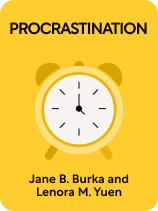

This article is an excerpt from the Shortform book guide to "Procrastination" by Jane B. Burka and Lenora M. Yuen. Shortform has the world's best summaries and analyses of books you should be reading.
Like this article? Sign up for a free trial here.
What role does emotional regulation play in procrastination? How does the inability to regulate your emotions prevent you from getting things done?
Beating procrastination is ultimately about learning to regulate difficult emotions. When you’re faced with a task, you can’t control what emotions arise, such as fear or dread. However, you can control how you regulate these emotions so they don’t overwhelm you and tempt you to procrastinate.
Here’s why procrastination is ultimately an issue with emotional regulation and what you can do about it.
The Brain Science Behind Emotional Regulation
According to Burka and Yuen, emotional regulation helps you calm your fears rather than exaggerate them. Your amygdala—the part of your brain that processes threats—produces fear when you encounter a task that consciously or unconsciously reminds you of negative, past experiences (such as family trauma or cultural marginalization). The amygdala sometimes exaggerates how threatening tasks are, pushing you to procrastinate. However, your frontal cortex—the part of your brain that thinks consciously—has the capacity to quiet these fears so they don’t take over and lead to procrastination. In this section, we’ll explore two emotional regulation behaviors for beating procrastination.
(Shortform note: In Emotional Intelligence, Daniel Goleman claims that techniques for emotional regulation help you manage not only fear and anxiety but also other unpleasant emotions such as anger and sadness. One tip he offers for managing any unpleasant emotion is to refrain from rumination. When you ruminate, you passively wonder what’s making you feel bad without taking any actions to make yourself feel better. Rumination drags out the negative feeling, only making you feel worse. For example, if you’re scared, you should refrain from re-imagining the trigger that made you scared. In the next section, we’ll describe two behaviors—mindfulness and exercise—that are healthier than rumination.)
Behavior 1: Practicing Mindfulness
Burka and Yuen argue that mindfulness provides you with time and space to regulate your emotions rather than letting them regulate you. Mindfulness is a millennia-old technique that emphasizes acceptance and focuses your awareness on the present. When you practice mindfulness, you observe your thoughts, emotions, and bodily sensations, accepting them rather than critiquing yourself for feeling the way you do.
The authors claim that mindfulness helps reduce the feelings of anxiety, fear, and stress that compel you to seek relief in procrastination. When a procrastinator typically anticipates a daunting task, their mind fills with fear (such as fear that the task will be too hard) followed by judgmental thoughts about those fears (such as “Everything is so hard for me…I must be a loser”). To practice mindfulness, instead try to notice your thoughts and emotions without judging them. Nonjudgmental noticing is a calmer state of mind than the judgmental spiral of anxiety. You’re more likely to tackle rather than avoid tasks when your mind is calm.
(Shortform note: In Mindfulness in Plain English, Bhante Gunaratana explains why watching and accepting the present without judging it helps you regulate your emotions. He claims that you have to accept rather than judge your present emotions, thoughts, and sensations to properly observe them. If you’re busy judging them, you’ll fail to observe them clearly. Furthermore, when you clearly observe and accept your emotions and sensations, you witness them arising and eventually passing. You realize your worries are temporary, a fact that comforts you and keeps you from becoming absorbed in those worries.)
Many practice mindfulness through meditation, but you can also practice it at any point throughout the day when you feel fear, dread, and anxiety in anticipation of a task. When you notice these feelings arising, pause for several seconds. Observe your emotions, thoughts, and sensations. Any time you catch yourself slipping into judgment, bring yourself back to the present moment by paying attention to your body (such as your breath or heartbeat). Pausing and reconnecting to the current sensations in your body halts the neural processes that amplify your fears. Lower levels of fear are easier to regulate and less likely to cause procrastination.
(Shortform note: Mindfulness takes practice, and it may be easier to engage in mindful moments throughout the day if you first hone your mindfulness skills through seated meditation. As Gunaratana explains Mindfulness in Plain English, you can practice seated meditation by setting aside 10 to 20 minutes for it every day. First, find a comfortable position, then close your eyes and take three deep breaths through your nostrils. Any time you notice your mind meandering, refocus your attention on your breath around your nose. Each time you refocus your mind on the present, you strengthen your ability to practice mindfulness in everyday life.)
Behavior 2: Exercise
Second, the authors argue that exercise gives you the energy to persist through your fear and seek out positive emotions. Let’s examine three benefits of exercise.
First, exercise boosts your mood. It releases endorphins, groups of hormones that generate positive feelings and leave you feeling optimistic that you’ll succeed on upcoming tasks. Second, exercise promotes clear thinking. Physical activity increases blood flow to your brain, helping you think more quickly and make new connections. This increases your capacity for persisting through challenging tasks.
(Shortform note: In The Miracle Morning, Hal Elrod argues that exercising should be part of your daily morning routine. Like Burka and Yuen, he argues that exercise elevates your mood and sharpens your ability to focus. By exercising early in the morning, rather than later in the day, you ensure that you experience the benefits of exercise for the rest of your day. This leaves you energized and empowered to spend each day crafting your ideal life.)
Third, exercise enables you to beat procrastination because it helps you set realistic expectations. Physical activity releases a protein that supports the formation of new neurons in your brain’s memory center (the hippocampus). A well-developed hippocampus helps you compare a present task to similar, past situations, enabling you to set realistic expectations for both your performance and its consequences. For example, imagine your fear of imperfection is causing you to procrastinate on writing a speech. Your hippocampus enables you to remember you’ve given satisfactory speeches before. Remembering this, you reassure yourself that this speech will be fine, too.
(Shortform note: Research shows that only some forms of exercise—in particular, aerobic exercise like cycling—develop your hippocampus. By contrast, forms of exercise that don’t get your heart rate up (such as stretching and resistance training) don’t develop your hippocampus.)
Burka and Yuen provide a strategy for making exercise part of your routine: Ensure the exercise itself is enjoyable and rewarding. Procrastinators often seek activities that are immediately rewarding. If completing exercise is the only aspect of it that’s rewarding, you’re likely to procrastinate on it. To make exercise more rewarding, consider setting up a recurring exercise time with a friend. The reward of connecting with your friend will make exercising more pleasurable as you do it, not just after it’s done.
(Shortform note: Burka and Yuen’s suggestion to exercise with a friend may not be compelling enough for introverts or people whose friends don’t share their love of exercise. In Predictably Irrational, Dan Ariely provides another technique you can use to make unpleasant activities (such as exercise) more enjoyable. He claims that you should multi-task by simultaneously engaging in an activity you find more pleasurable—one you’ll commit to only doing with the unpleasant task. Your brain will form a connection between both tasks: You’ll feel motivated to engage in the unpleasant task, as it’s the only time you can also engage in the pleasurable one. For instance, only listen to your favorite podcast when you’re working out.)

———End of Preview———
Like what you just read? Read the rest of the world's best book summary and analysis of Jane B. Burka and Lenora M. Yuen's "Procrastination" at Shortform.
Here's what you'll find in our full Procrastination summary:
- How to identify the fears that lead you to procrastinate
- How your biology, circumstances, and self-esteem affect your procrastination
- How to better control how you manage your emotions and time






